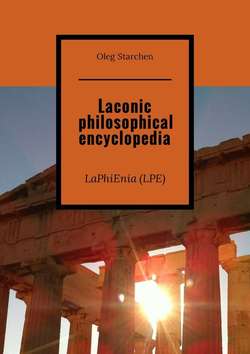Читать книгу Laconic philosophical encyclopedia. LaPhiEnia (LPE) - Олег Старчен - Страница 8
300 LACONISMS
E
Оглавление34 the EUROPEIZATION OF SUPRAMENTALISM
Sri Aurobindo Ghosh joined Hegelianism and Indian philosophy and received as a result supramentalism, Europeization of which made Zeazrosophy.
35 the EUROPEIZATION OF PHILOSOPHY
Thales of Miletus and other ancient Greek philosophers carried out the Europeization of philosophy, so that philosophy did not remain the privilege of the East, India and China.
36 the EVIL IS ATAVISM
Gorilla is not so evil as chimpanzee and human. This is because the gorilla is less related to humans than the chimpanzee.
Evil is an atavism, inherited from his evolutionary ancestors, which were not yet social. Therefore, human tries to fight evil, because he lives in a society where evil is not only no longer useful, but also became harmful.
Note. See the book Categorics.
37 the EXTRAUNIVERSAL PHILOSOPHY
It is difficult even to imagine on such philosophy. The General theory of supramentality shows that in other Universes will be the superconsciousness abilities, adequate to these Universes.
38 the EUCONFABULATORICS
According to the hygiene and euconfabulatorics, to clear the memory from unnecessary and harmful memories is important just as washing hands.
Diogenes Laertius in his famous book writes that Antisthenes, the founder of cynicism, believed that it was “science to forget unnecessary – the most necessary science”. In this regard, it is interesting to philosophize about such a possible philosophical science. Such a science can be called as Euconfabulatorics. Etymology of the term: “ευ” means good (according to old-gr.), “confabulation” (in lat.) means the imaginary memory. Elementary hygiene agrees with Euconfabulatorics, this the most necessary science of Antisthenes.
39 the EMBLEM OF PHILOSOPHY
Let the emblem of a philosophy is the heart and spectacles. The heart symbolizes love, and the spectacles symbolize wisdom, not just a lack of vision.
Review. “On the spectacles… are you sure?”
(Gregory Fox Galaktion, 01.25.2012)
Note. α. This work was first published in 2012. Only later the author learned that the symbol of polyamory (i.e., the theory of love not to a single woman, but to many women at once and at the same time absolutely sincere love) is surprisingly similar to the proposed emblem of philosophy, namely: the emblem of polyamory – the symbol of the heart, on which is the symbol of infinity. Thus, the emblem of philosophy is the emblem of Philogyneya as polyamory.
β. Here’s what about the philosophy’s emblem was published after my publication in 2012: https://otvet.mail.ru/question/89935161
40 the EPITHETS OF PHILOSOPHY
One of the possible epithets of philosophy – is a sunny philosophy.
(Do not confused with “Epictets of philosophy”, i.e., of the stoic philosophers, variously congenial claiming that happiness is subjective, and not objective, a nominal name from the ancient Roman philosopher Epictetus)
Philosophy deserves many epithets. Therefore, they are multitude in quantity and multitude in quality. For example, concise or laconic philosophy (Laphienia), categorical (Categorics), supramental (Zeazrosophy), imaginary (Orgaosophy), philogynic philosophy (Philogyneya), etc.
41 the ERGAOSOPHY
Óργ or Εργ by old-gr. means “work.” The meaning of Ergaosophy: this is a working philosophy, in contrast to philosophy an idle, in contrast to lazy philosophy.
42 the ESCALATOR OF PHILOSOPHY
Unlike Wittgenstein’s “Logical-philosophical treatise” as a ladder, Zeazrosophy – escalator of philosophy and knowing, self-propelled to the height, to reach the top of philosophy and knowledge.
43 the ETHICS OF IMAGINATION’S IMAGINATION
Such ethics is based on the principle: “imagine the imagination of a person in relation to you, with whom you act, and act so that this person has no reason for the desire to imagine a bad act, word or deed, in relation to you.” Imagination of imagination is empathy. It’s something like of overmibd by Kordemsky, that he meant, however not using this term in the book “Mathematic savvy” in the task of the “Three wise men”, in which the sages laughed.
44 the ETHICS OF TWINGE OF CONSCIENCE
Ethics of twinge of conscience is Zeazrosophy i.e. philosophy about the True over-thinking (zeazrovning). Ethical term the twinge of conscience [literally “zazrenie”] and the epistemological term the zeazrovning [literally “zeazrenie”] differ only in one letter, the letter E. There is a close metaphysical connection between them. One zeazrovning not enough for the good of mankind, it is necessary also twinge of conscience as genetically innate and inborn function of the psyche of future Superthinkers, coupled to zeazrovning. Otherwise, over-thinking and zeazrovning will be not for good but for evil, not for benefit but for harm.
45 the ETIOLOGY OF EVIL
Human evil is a painful psychological atavism inherited to mankind because of pathological genetic inheritance from ape-like ancestors. This idea was first invented by William Gerald Golding, an authoritative writer. Knowledge of etiology, i.e. the origin of any pathology, helps its diagnosis, prevention, and healing.
46 the EXTRAORDINARY PHILOSOPHY
The philosophy of the XXI century A.D. should be Extraordinary. Ordinary philosophy was previously.
